| |
|

FRIDAY, SEPT. 12 - SUNDAY, SEPT 14 Temple Emanu-El dedication weekend.
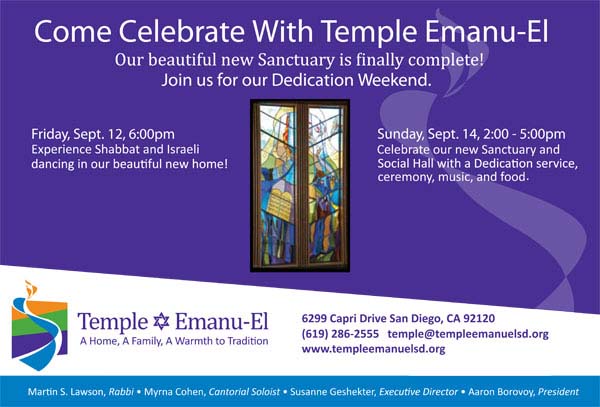
MON., SEPT. 29-THURS., OCT. 9

TEMPLE SOLEL High Holy Day Greetings


Please actively support San Diego Jewish World

LETTER FROM JERUSALEM
Israeli professor worries over course his native United States is taking in world
By Ira Sharkansky
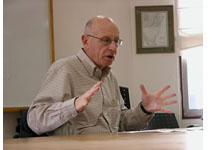 JERUSALEM--This election campaign is compelling me to look again at a country I left more than 30 years ago. JERUSALEM--This election campaign is compelling me to look again at a country I left more than 30 years ago.
I wrote the following to some internet friends.
It's not too much of a stretch to see the presidential campaign focusing on:
Who is better looking? Obama or Palin?
Who gives a better speech? Obama or Palin?
Who has less experience? Obama or Palin? If that is the way the world's most powerful country selects its leader, God help the rest of us.
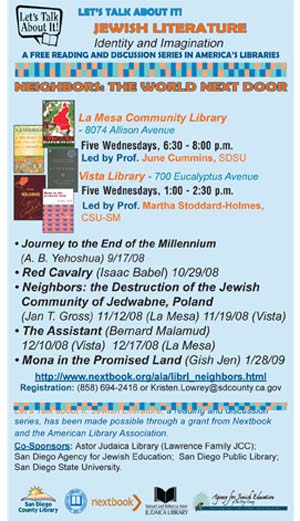 One member of the group wrote to me: One member of the group wrote to me:
You may think this is clever. I think it's insulting.
I grew up as an American patriot. From kindergarten through sixth grade in my public school during the 1940s, I said the Lord's Prayer and saluted the flag every morning. My parents were Republican and my father a McCarthyite.
I am not altogether certain why I came to Israel. I did not flee the United States. I had a good career there, and felt comfortable interacting with people at the summit of national and state government, as well as the military. I have also done well here, occasionally mixing with the elites of several sectors. My students have dealt with presidents and prime ministers.
I do not claim to have influenced either the United States or Israel, but I think that I have learned by observing both countries, and numerous others where I have traveled or resided.
I both admire and fear the United States, and pity many Americans.
The United States is the source of most advances in medicine and gadgetry that make life longer and more productive. The aspiration of creative Israelis is to develop something of value, polish it in the context of a start-up, and sell it for $100 million or more to an American company. We read about one of more of those just about every month.
The size and wealth of the United States has a lot to do with the discoveries and inventions. The structure of taxes and government outlays rewards investment and creativity. Yet they weigh heavily on all but those fortunate enough to have access to the best education and medicine. The students I have met on numerous campuses impress me as woefully unprepared for life. I pity adults who are not healthy, and do not enjoy unusual insurance. They suffer from medical opportunities both stingier and more difficult to comprehend than those in Israel and Europe.
Israel has, without a doubt, benefited from American patronage. Yet American adventures elsewhere in the Middle East have added to the dangers of Americans and the rest of us. I worry about American insistence in influencing the details of Israel's relations with its neighbors. The Secretary of State insists that Israel move a roadblock and avoid building an apartment block, while not chiding the Palestinians for their insistence in moving the clock back by 60 years.
A prospective Vice President says that she receives policy guidance from the Bible. As long as she reads the Bible as I would want her too, I can sleep well. But it is possible to find a variety of commandments in the Bible. I would prefer another way of making policy. While most Vice Presidents spend four years attending ceremonies, this Vice President, if elected, will be the backup of a President who shows signs of his age. Barack Obama has an impressive education, but not much experience. Some of his advisors are frightening in what they have expressed about Israel and Palestine.
Americans chide me for my comments. It is their country, and they will decide who rules.
That is only partly true. Outsiders may not vote, but given American inclinations to police the world and intervene where they will, residents of every country have a right to express themselves. Bill Clinton proposed drawing an international boundary 100 meters from my home. Condoleezza Rice has been insistent about areas that I see from my balcony. My neighbors in French Hill have as much right as residents of Hope, Arkansas, Birmingham, Alabama, or Wasilla, Alaska to comment on the choice of an American President and Vice President.
Most of all, I would like modest aspirations about remaking the Middle East and elsewhere. There is no sign of that in any of the candidates.
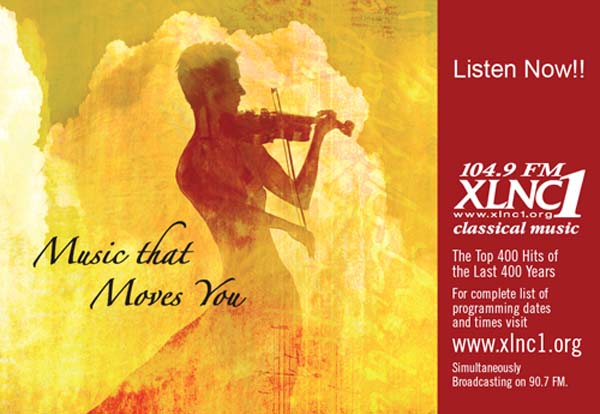


FROM THE SIDELINES
Non-practicing vegetarian chooses
to make a kosher compromise
By Rabbi Dow Marmur
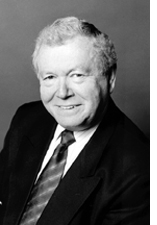 TORONTO, Canada—I'm a non-practising vegetarian. I believe it's problematic to eat animal flesh, even after it has been decoratively camouflaged and tastefully seasoned before serving. Despite expert opinion that, in addition to providing necessary sustenance, meat is the most reliable supply of protein, I have serious qualms. TORONTO, Canada—I'm a non-practising vegetarian. I believe it's problematic to eat animal flesh, even after it has been decoratively camouflaged and tastefully seasoned before serving. Despite expert opinion that, in addition to providing necessary sustenance, meat is the most reliable supply of protein, I have serious qualms.
But I continue to eat meat with gusto – because I love it. I find substitutes, even when they're wholesome, almost invariably unsatisfying. So I don't live according to my conviction. Like with so much else in life, I compromise.
Jewish tradition helps me in this by providing a time-honoured dietary discipline in the form of kosher food. It prevents me from eating some meat – pork and many other products – and shellfish. It assures me that the animals permissible for consumption were healthy and have been slaughtered in a humane way (if that's not an oxymoron), and that all blood has been drained from the meat before it comes to the table. I feel, therefore, that Judaism gives me permission to eat meat.
Even here there are degrees of observance – from the rigid to the relaxed and at times inconsistent. Sometimes I cut corners, usually in the name of compromise.
I'm encouraged in my ways by an article in the Aug. 28 issue of the International Herald Tribune that describes how many citizens of contemporary India deal with the same problem. Though they believe that meat-eaters are aggressive and unclean – "you are what you eat" – author Anand Giridharades shows how the young particularly are trying to balance the world of KFC, McDonald's and Pizza Hut, as well as the fancy restaurants to which the country's growing middle class now has access, with the tradition in which they were reared.
Echoing the Canadian sociologist Reginald Bibby, who has written about contemporary inconsistencies as "religion a-la carte," Giridharades profiles young Indian urbanites treating "tradition and modernity like a buffet rather than an all-or-nothing choice." Like many Jews and Muslims (who share the basic Jewish restrictions about meat), I find myself in the same boat.
My situation has been further complicated because of revelations about ethical malpractices in one of North America's largest kosher slaughterhouses in Postville, Iowa. As a result, several Jewish organizations have issued new guidelines that add to the ritual requirements ethical criteria about conditions in the workplace, fair wages, etc. Others add "eco-kosher" to their criteria for healthy Jewish practice.
They fear that the situation in Postville may push more Jews away from dietary observance altogether to abandon what Giridharades describes as efforts "to compromise with the past in order to save it – and how to be modern without being like everybody else."
How important that is has been brought home to me by my 14-year-old granddaughter. Though a regular teenager in every sense of the word, she has chosen to abstain from meat in order to assert her individuality in the family and, perhaps unwittingly, also to show that the most consistent dietary discipline from a Jewish point of view is to abstain from meat altogether. Like most of her peers, she doesn't approve of compromises.
In his book, The Religious Case Against Belief, James Carse argues that "the religions are simply not reducible to tidy formulas or rigidly ordered credos." Fanatics will always find it easier to take sides for or against any issue, not least diet. We who try to lead a religious life while living in the world may have to accept compromises. Some call it wisdom.


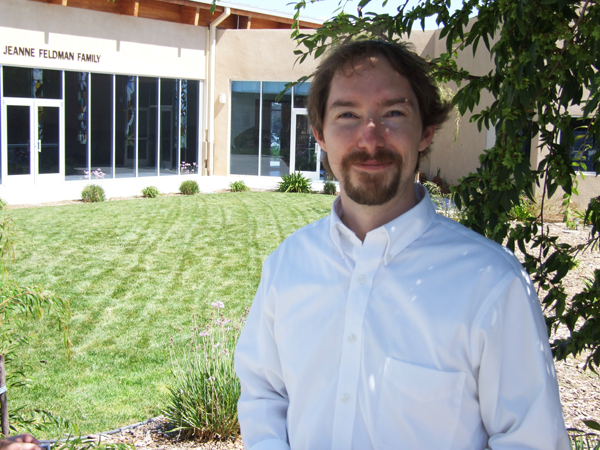
THE JEWISH CITIZEN
Undeterred by vandals, Ner Tamid leaders predict bright future for the congregation
By Donald H. Harrison
 POWAY, California—Utterly unintimidated by vandals who desecrated the street marker on busy Pomerado Road below their congregation a week ago, members and staff of Ner Tamid Synagogue spoke at a barbecue yesterday about how they plan to combine religious services, congregational social events and K-7 Torah School education into an overall program exemplifying the “joy of Judaism.” POWAY, California—Utterly unintimidated by vandals who desecrated the street marker on busy Pomerado Road below their congregation a week ago, members and staff of Ner Tamid Synagogue spoke at a barbecue yesterday about how they plan to combine religious services, congregational social events and K-7 Torah School education into an overall program exemplifying the “joy of Judaism.”
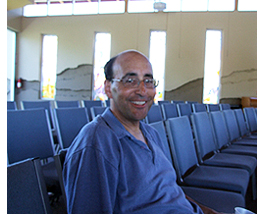 Mitchell J. Freedman (right), a trial attorney who serves as congregational president, said a swastika and other graffiti was one half of a paradox of 21st century Jewish life. “The flip side of that was that the people across the street who aren’t even Jewish came over that morning , before anyone here noticed it, with towels and blankets” to clean it up. Mitchell J. Freedman (right), a trial attorney who serves as congregational president, said a swastika and other graffiti was one half of a paradox of 21st century Jewish life. “The flip side of that was that the people across the street who aren’t even Jewish came over that morning , before anyone here noticed it, with towels and blankets” to clean it up.
When the early morning vandalism was inspected by a synagogue member who is an FBI agent, “people came over to her and said ‘this is a horrible thing; we will be watching over your property.’ The difference—what Jews did not have in Germany is the police, who here are on our side.
“We need to keep people from losing perspective," Freedman added. “We need to be vigilant, we’re going to get those guys, police are doubling their efforts, but we are never going to get rid of anti-Semitism and our kids are learning that. But we also want them to know that they live in a place where people will speak up early, clearly and confidently.”
Freedman said he agrees with Ner Tamid’s new education director, Naomi Gabai-Fisher, who spent 11 years in a similar position at Congregation Beth El in La Jolla and the last two years teaching Jewish subjects, that whereas such subjects as anti-Semitism, the Holocaust, and the tremendous challenges facing Israel need to be taught, there also is a need to present Judaism as “a religion of life, not of a series of horrific events that we survived.”
“I want them to realize that there is much wisdom in Judaism,” said Freedman, whose obvious energy seemed a physical contradiction to the fact that he just underwent heart surgery a week ago.
“I have been trying to instill the philosophy that this should be a place that people should be coming not just for davening but for an event like a barbecue, or a speaker,” he added. “We are starting yoga cases, for the moms who drop their kids off. We have in our congregation a woman who teaches elsewhere on Wednesdays, and we said ‘do you mind doing it here?’ And there is a lot of excitement.”
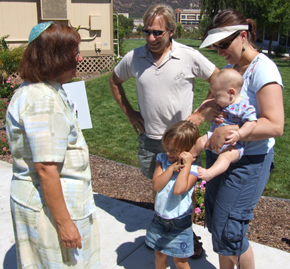 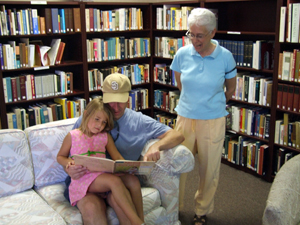
Gabai-Fisher said her goal for the 42 students now enrolled in the Conservative congregation’s school is to instill within them a love of being Jewish. “They should take joy in being Jewish, feeling that they are a part of the Jewish community anywhere, and also have the skills to be able to move from one community to the next around the United States and to be comfortable in any Jewish setting.”
Nadav Caine, a rabbinical intern who has been serving the congregation, will be traveling after the High Holidays to Israel for eight months of study as part of his American Jewish University program in Los Angeles that is expected to lead to ordination in 2011. Nevertheless, Caine he will remain an interactive part of the school children’s education thanks to computer hook-ups that will allow him to speak with the students on Sunday mornings in Poway, which correspond to Sunday evenings in Israel.
“Rav Nadav,” as he is known to his congregants, is not your usual rabbinical intern. He was working towards a doctorate in Jewish philosophy and religion when he decided to follow in the rabbinical footsteps of his father, Rabbi Ivan Caine of Philadelphia. At the time he switched majors, his doctoral program advisor, Dr. Arnold Eisen, also made a career change, becoming the chancellor of the Jewish Theological Seminary in New York. Today, Nadav Caine is the oldest rabbinical student in his class, a factor he said was important in his being granted permission to serve as Ner Tamid’s spiritual leader even in advance of ordination.
For the High Holidays, Caine has persuaded a physician friend, who also is the child of a rabbi, to serve as cantor for the congregation. Dr. Sharna Shachar, has “an incredibly sweet voice” and is knowledgeable, Nadav said. But rather than simply performing the traditional chants and melodies, Shachar and Nadav are planning services they hope will exemplify the spirit of participation rather than performance in the sanctuary.
Caine said he attempts to bring to the congregation spiritual writings from Jewish and non-Jewish sources, and hopes that during the High Holidays, that “instead of just talking at people, we will have them share their own experiences of Judaism with each other.”
“The synagogue should be a community; it is not about audience,” he said. “It really is an extended family. We should know where people are coming from and their stories. I agree with Muriel Rukeyser, the Jewish poet, who said the world is not made of atoms, but of stories, and that is the kind of approach we are taking.”
During Caine’s absence, pulpit duties will be taken over by his father, who has retired from his Philadelphia position. Freedman, the congregation’s president, said after Rabbi Caine’s last visit to the congregation, children began calling him “Grandpa Rabbi” to differentiate him from “Rav Nadav.”
There will be another lure for parents besides the yoga class when they take their children to Sunday school; the Laura B. Friedman Library, named for the late wife of congregant Alvin Friedman. It has soft comfortable chairs and two large couches serving as encouragement to parents to sit down and read while their children learn in the school trailers nearby.
Co-librarians Susan Burke and Myla Stokes Kelly have labeled and shelved nearly 2,000 Jewish-interest books both for juveniles and adults. Burke, who was on duty for the Sunday barbecue, is a retired librarian who worked in Baltimore prior to moving to San Diego ten years ago. In the interim she had served as a reference librarian at Mira Costa and Palomar Colleges.
Ner Tamid’s collection, which had been in an upstairs room of the congregation back in the days when it was housed in rented quarters in Rancho Bernardo, includes “some amazing text books, a complete set of the Talmud in English… a lot of biographies and mucho novels,” Burke said.
“I spent all this time organizing this stuff, getting it on the shelves,” she said. “My aim this year is to get them off the shelves.”
The library may be accessed whenever the synagogue is open with congregants encouraged to check out books. Gabai-Fisher said it also will be a good source of material for students in higher grades doing research reports, and a fine repository of story books for children in lower grades.


REFLECTIONS
A new daughter embraces the Covenant
By Sheila Orysiek
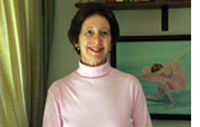 SAN DIEGO—As one reads the long history of our people one can’t help but wonder at the tenacity of purpose and commitment demonstrated through the centuries. We have been known by many names - Hebrews, Israelites, Jews, Israelis, Sephardim, Ashkenzazis - but we are in fact one people with many faces. Scholars have explored the whys and wherefores of our belief as well as our survival. I prefer to think of it as a miracle manifest in the existence of G-D. SAN DIEGO—As one reads the long history of our people one can’t help but wonder at the tenacity of purpose and commitment demonstrated through the centuries. We have been known by many names - Hebrews, Israelites, Jews, Israelis, Sephardim, Ashkenzazis - but we are in fact one people with many faces. Scholars have explored the whys and wherefores of our belief as well as our survival. I prefer to think of it as a miracle manifest in the existence of G-D.
Our history is both a litany of triumph of belief as well as a vale of tears as a consequence of that belief. Many through the ages have sought to escape from the cauldron of this complex inheritance by opting out of their birthright and opting into the culture of the majority around them. Sometimes they have done this willingly and sometimes as a last resort to purchase the remainder of their lives.
For those who were confronted by the fact that becoming part of the majority was the only way to secure their lives, we who have not had to face that crossroads hesitate to judge them. Who amongst us can say what decision we would make in choosing life or the pyre in an auto de fe? For those who chose to leave behind their heritage for other reasons such as social acceptance in the larger society, feelings range from understanding to sorrow.
In light of this long history of making choices, the question then arises why would anyone want to do the reverse and voluntarily choose to join this often tortured history? Why indeed forfeit membership in the accepted majority? That someone would convert from the majority and enter a Covenant which has as often been a trial as it has been a reason for spirituality, is a wonder.
It was something I had not thought about never having known anyone who had chosen to join the walk through life as part of the Jewish family. This changed three years ago when I joined a Temple and during the Sabbath services the Rabbi announced a Gerut ceremony would immediately follow. This I decided I had to see.
When one is born into the Jewish community, whether observant or not, bar/bat mitzvahed or not, we are still considered part of the whole. But for one who is outside the fold to make a conscious decision to join - to put aside previous religious affiliation - to spend months - even years - studying, must be an experience unlike any other. The applicant not only has to look ahead, but also behind. What, if anything will be left behind? How will family react? Will friends be supportive?
When Pope John Paul II died, I remember a Catholic official was asked how soon the deceased Pope would be canonized. He answered: “The Catholic Church thinks in terms of centuries” - implying, of course, the long history of the church. Judaism, however, thinks in terms of millennia. For someone seeking to join our body, this is a heavy history - a heavy yoke - to undertake.
One convert-to-be told me she has felt this pull because she has reason to believe that her family was originally Jewish, hid their Judaism by becoming Conversos, and fled Spain for South America to escape the Inquisition. Another who several years ago joined the Covenant had no such family history, no overt or covert connection to Judaism but felt an irresistible pull to become a Jew. She said it brought her a feeling of contentment - of finally being at home.
I enjoy attending these rites of entry because I think someone who is not immediately related as a friend, relative, or an office holder of the Temple, but simply an ordinary member of the congregation, should also be a witness and thus part of the proceedings. I like to think in my very small way I can represent the unseen body of our people welcoming in a new soul.
These Jews by choice are obviously awed by what they have chosen to do. Some react with tears of relief, some with smiles and tears and some feel the need to speak to those in attendance. One in particular spoke at length without any notes - from her heart - and what she said lifted everyone present to a new level of understanding of the heritage into which we were born. She said: “I know your history. I want to join that history. And whatever happens to you, I want to happen to me.”
For those in our community who take their heritage for granted, who easily overthrow it, or ignore it, though softly spoken her words rang through the Sanctuary and no one in attendance remained untouched. Every eye was wet. A new heart and soul had willingly worked to join the congregation at the foot of Sinai and become part of the Covenant.
This is not only a statement of religious philosophical acceptance but also an acceptance of the possibility of physical jeopardy. In almost every generation of our multi-millennial history someone somewhere has threatened our existence both actually and potentially. That alone should give pause to anyone expressing a wish to join the descendants of Sinai. However, despite knowing the inherent threat, they do what they need to do and join. One has to admire such conviction.
On Friday night, September 5, 2008, the first Jew by choice in Temple Emanu-El’s new Sanctuary was given and accepted a Torah Scroll to which she plighted her troth. This particular Torah Scroll which Rabbi Martin S. Lawson placed in her arms is a Holocaust survivor, having been buried by loving hands as the Nazis approached Eastern Europe. Over two hundred years old it is now at home in Temple Emanu-El’s beautiful new Sanctuary. As it was received by this newest Jew, she also became part of its history, ready to share its blessing and burden.
Her road to this moment was not an easy one. The Rabbi sets a high standard of study, testimony of good faith, an understanding of our history, religious concepts, obligations, Mitzvot, mikvah and Bet Din. He meets with the prospective Jew by choice many times. The applicant attends classes, writes lengthy essays, and has to demonstrate both understanding and a free will. Many of us who were simply born into the Covenant can only wonder at the commitment required to travel this road.
And so there is now a new daughter to welcome and embrace into the fold. We are all strengthened by her presence. Her affirmation confirms ours.

CONGREGATIONAL CURRENTS
Sharing a meal at Chabad of La Costa
By Gerry Greber
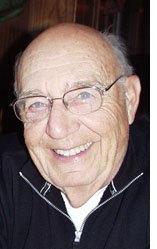 CARLSBAD, CALIFORNIA—Once a month Chabad of La Costa plays host to a “Friday Night Community Meal” preceded by the regular Friday evening service. Everyone in the Jewish community is invited to attend. Marilyn and I had the opportunity to participate and we found it a most enjoyable evening. CARLSBAD, CALIFORNIA—Once a month Chabad of La Costa plays host to a “Friday Night Community Meal” preceded by the regular Friday evening service. Everyone in the Jewish community is invited to attend. Marilyn and I had the opportunity to participate and we found it a most enjoyable evening.
The ladies were not present in the sanctuary during the service. Instead, they were in another room, Chabad style, lighting candles to commence the Shabbat, and preparing the celebratory meal to follow. Marilyn and other ladies lit a large number of candles in honor of members of the families present.
While waiting for the service to begin, I chatted with two regular Chabad attendees, Neville Cohen and Mel Bridges.
Rabbi Yeruchem Eilfort spoke about his recent weekend adventure with a group of young people, and then conducted a Shabbat service with the help of Assistant Rabbi Michoel Shapiro. From my point of view, Kabbalat Shabbat at Chabad of La Costa was a traditional service except some of the melodies were different, particularly the “L’cha Dodi” which welcomes the Sabbath “bride.”
After the service, the men joined the women and everyone said a bracha, washed their hands and sat down to enjoy the Shabbat dinner. At the table were 14 adults and “about” seven or eight children. I say “about” since it was hard to keep track of them. They were eating and running and laughing. In general they appeared to be having a wonderful time, and surprisingly, they did not interfere with the adult conversations at any time.
During the dinner the conversation was lively and interesting. Those with young children spoke about the programs they, the children, are involved in to learn Hebrew, among other things. I learned from Rebbetzin Nechama Eilfort about a special world-wide program to teach children how to read, write, and speak, the language of the Torah–while sitting at home (or in the Chabad) in front of a computer. They talk with teachers in various parts of the world, with whom they are able to communicate on a face-to- face basis thanks to webcam technology. According to Rebbetzin Eilfort, there are thousands of children participating in this program including her two eldest boys.
During the meal Rabbi Shapiro sanswered questions posed by the guest about the weekly Torah reading. He said that when the Exodus occurred only about 20% of the Jewish people living in Egypt were willing to leave. The others, for one reason or another, did not want to venture out into the desert. Those that remained, Rabbi Shapiro said, all passed away shortly following the tenth plague.
The evening came to an end with Rabbi Eilfort leading us in “Grace After Meals."
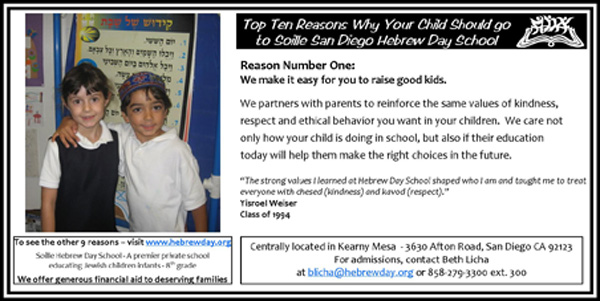

ARTS IN REVIEW
Picking right shows for teenage grandkids
By Carole Davis
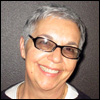 SAN DIEGO—As many of you know by now, being in the theatre for me is like coming home. When my late husband Gerry and I started writing (more years ago than I admit to remembering) our children knew exactly where we were and if they needed us they knew they could always find us. Mind you this was in the Stone Age before cell phones. Back then we both shared a column and equally enjoyed the theatre. SAN DIEGO—As many of you know by now, being in the theatre for me is like coming home. When my late husband Gerry and I started writing (more years ago than I admit to remembering) our children knew exactly where we were and if they needed us they knew they could always find us. Mind you this was in the Stone Age before cell phones. Back then we both shared a column and equally enjoyed the theatre.
As the girls grew we took them with if they chose. When my husband passed away, they would take turns coming with me. Looking back, I hope it wasn’t out of obligation, because believe it or not, my friends were lined up to take their empty seat. Those who blamed me for a show that did not live up to expectations quickly were deleted from the long list until I had a short list of theatre lovers who enjoyed the experience and were willing to refrain from offering me their reviews. Comfortable alliances were formed over the years and I am comfortable either going alone or being in the company of like-minded theatre lovers.
When my grandchildren were old enough to come with me, they were always my first choice. From Joseph and the Amazing Technicolor Dreamcoat to Beauty and The Beast to yes, Phantom, we schlepped to the theatre any and every time something age appropriate was showing. When they moved to Israel, they were the first to check on line to see what was coming to San Diego when they were coming back for a visit. Over the years we have seen musicals, comedies and tragedies. This year was no different with the exception of a slight diversion, the birth of their new cousin. But we did manage to see two shows, Spring Awakening and Les Miz.
Now that both grandsons are in their teens, they vie for first in line. It’s always a challenge to give equal time to two entirely different personalities, as you can imagine. The oldest (only by 19 months) doesn’t always show that much of an inclination or enthusiasm (he’d rather ICQ his friends in Israel) whereas his brother will go to see anything I suggest. Over the years we have been theatre buddies extraordinaire. This time around, however, I knew immediately which personality was suited for what.
Spring Awakening, the long awaited Tony Award winning rock musical hit the Balboa Theatre downtown with both feet on the ground as it made its west coast premiere in our fair city. Billed as this generation’s Rent and last generation's Hair, the story is base on the infamous 1891 Frank Wedekind play Awakening of Spring.
Dunkin Sheik and Steven Sater’s score along with Bill T. Jones' choreography and Sater’s book take the audience on the same roller coaster ride, that of reaching puberty with all the little discoveries and pain of coming of age that the children in his book faced. Mind you, this story was written over one hundred years ago and while our computer age generation of teens has all the answers, and I would venture to say experience at its fingertips, the characters of Wedekind’s generation of German teens were completely in the dark! It was an age of repression and denial.
Wedekind referred to the drama as “a tragedy of childhood." It deals with a group of school children just entering the age of puberty who explore the mysteries of life, which are only learned through their own discovery by way of sharing experiences and secret findings.
With a talented, young and able cast headed by Kyle Riabko as Melchoir and Christy Altomare as Wendla— the two young lovers— and Blake Bashoff as the misguided Moritz and Andy Mientus as Hanchen, the eerie antagonist, the musical moves along in part dream- like atmosphere, part reality and part tragedy. Bill T. Jones' choreography and a live band on stage add to the overall look especially with Christine Jones’ fussy backdrop and Kevin Adams’ lighting. Another interesting prop was that parts of the audience were sitting on stage with the cast members sitting among them.
Most of my friends gave me an A+ for taking my 18-year-old grandson, Eytan to see a play about sexual repression and coming of age. But for one scene in the play, I was completely at ease and was pleased we could have an adult conversation about the subject matter without the restrictions leveled at the characters in the play. If it comes around again, take a family member. It will be an eye opener.
Later on in their stay, I took my 16 year old Gil up to Moonlight Amphitheatre to see Les Misérables, the epic musical drama adapted from Victor Hugo’s book of the same name. Gil, a musician who loves all kinds of music and plays the guitar, was the perfect candidate for this moving musical which plays out more like an opera than an epic novel.
While it follows the lives of several characters over a 20-year span in the early 19th century France, it’s the music and lyrics (Claude-Michel Scöenberg and Herbert Kretzmer and Alain Boublil) with book by Claude-Michel Schöenberg and Alain Boublil that has kept this Tony Award winning musical alive since hitting Broadway in 1987.
Moonlight Amphitheatre in Vista has always produced ‘a cut-above productions’ every summer and this was no exception. From the absolutely perfect orchestration under the baton of conductor and musical director Elan McMahan to the extraordinary operatic voices of (real husband and wife) Richard and Sara Bermudez as the lovers Marius and Cosette to the charming Ari Krasner (a product of J* Company) as the young urchin, Gavroche, who dazzles everyone with his spunky rendition of Little People, this show was outstanding.
Steven Glaudini directed with his usual flair and Danny Gurwin plays the super human ex-con Jean Valjean with skill and agility making him one of the more believable Jean Valjean’s. Sam Smith is the obsessed Inspector Javert who just can’t let Valjean get on with his life. His strong baritone voice carried him well the night we saw the show.
For the comic relief James W. Gruessing, Jr. and Debbie Prutsman are the Thénardiers, the con artists and petty thieves who literally steal the fillings from the dead soldiers mouths after one of the many small battles. Their “Master of the House” brings the house down. You might recall some of the other tunes from the show: "I Dreamed a Dream," "Bring Him Home," "Do You Hear The People Sing?"" On My Own,
"
A Heart Full of Love" and "Empty Chairs at Empty Tables."
I was a little concerned that Gil might not endure a three-hour outdoor musical of these proportions, but then I forgot that he had already gone to a concert at Cricket Auditorium for the whole day a week before. Ah youth!
See you at the theatre.

Upcoming events of the Jewish American Chamber of Commerce
Gilianna hosts a September mixer at La Dolce Vita, 1237 Prospect Street, Suite P., La Jolla. Enjoy a little piece of Italy nestled away in the heart of La Jolla, while Chanukah shopping for Israeli made jewelry art and Judaica. Meet with owners of diverse businesses who are committed to develop synergistic collaborations. Online registration at www.jewish-socal.com $13 for members, $18 guests; tickets at the door $20 member, $25 visitor.Tuesday, September 16, Hilton Del Mar, 15575 Jimmy Durante Blvd; Thursday, September 18, Westgate Deli, 1055 2nd Avenue. This exclusive club brings together a small. diverse group of professionals who strive to grow, be inspired, and provide their clients with the best solutions to their needs, by forging collaborations with professionals in other fields.Sukkot mixer in the sukkah of Congregation Beth El, where our member and health insurance advisor Darren Todd will discuss the features and benefits of the new Group Health Plan for members. Host Rabbi Philip Graubart will talk about business and Judaism, and we will all schmooze while noshing on some of the best kosher dishes offered by the French Gourmet. On line registration at www.jewish-socal.com $13 for member, $18 for visitor. Ticket at the door $20 for member and $25 for visitor.



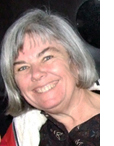 Nancy Harrison Nancy Harrison
cruise & tour specialist
(619) 265-0808
.

ADVENTURES IN SAN DIEGO JEWISH HISTORY
Editor's Note: To create a permanent and accessible archive, we are reprinting news articles that appeared in back issues of various San Diego Jewish newspapers. You may access an index of the headlines of those articles by clicking here. You may also use the Google search program on our home page or on the headline index page to search for keywords or names.
Fund Ends Year With Over $207,000
From Southwestern Jewish Press, January 13, 1950, page 1
Continuing the plea to those persons in our community who have not yet contributed to the United Jewish Fund for 1949, Max Rabinowitz, treasurer, announced that over $207,000 had been pledged in 1949, with $165,000 collected in cash to date.
“1950 can be made a brighter year if those who want to share in our responsibility to Jews who need our help desperately will only do so now,” Mr. Rabinowitz said.
Every dollar brings hope and care to those who live in tents in Israel, to those who exist in grim despair in Moslem countries, to all of us in this country who are building our lives in dignity and security.
Mail your check NOW to the United Jewish Fund of San Diego, 333 Plaza.
Institute to Feature Course in Mental Hygiene
From Southwestern Jewish Press, January 13, 1950, page 1
Featuring three new courses, the Institute of Jewish Studies will open the second semester on Wednesday, January 11, at the Tenmple Center.
Dr. A.P. Nasatir, Dean, announced the opening of a new course in “Mental Hygiene Problems of the Jewish Family,” “Jewish Music and Art,” and the “Contemporary Jewish Scene.”
Courses will be continued in Advanced Hebrew, Contemporary Religions, Cooking, Basic Judaism, Modern Jewish History, Literature of the Bible, Talmud and Book Reviews.
“Mental Hygiene Problems” will be conducted by Dr. Irving R. Stone, senior Clinical Psychologist, San Diego State Mental Hygiene Clinic. The course will have as visiting lecturers Dr. Benjamin B. Faguet, Chief Psychiatrist of the Clinic; Mary Lou Prawl, Nevin Wiley and William Long, Psychiatric Social Workers; Dr. Jack Levitt, Psychiatrist, and Professor Oscar Kaplan, associate Professor of Psychology, San Diego State.
Other courses will be taught by Rabbis Morton J. Cohn, Monroe Levens and Baruch Stern, Dr. A. P. Nasatir, Dov Abramis, Professor Ernest Wolf, Albert A. Hutler, Professor Harry Ruja, Mrs. Al Neumann and Mrs. Harris Rubel.
Registration will continue thru Wednesday, January 18, and may be made on that evening or by calling F-0171.
The Institute of Jewish Studies is sponsored by the Jewish Education Commission made up of Temple Beth Israel, Tifereth Israel Synagogue, Beth Jacob Synagogue, and the United Jewish Fund of San Diego.
Youth Aliyah To Present Film
From Southwestern Jewish Press, January 13, 1950, pages 1,8:
Three beautiful traditional Jewish ceremonials, never before photographed for a motion picture in their present form are the high spots of a unique hour-long feature film entitled “Tomorrow’s a Wonderful Day,” which will, be released here at the Hoover High School Auditorium on Jan. 21, under the sponsorship of the local chapter of Hadassah, the Women’s Zionist Organization of America.
There is a Hanukah ceremony in a Children’s Village in which several hundred young refugees take part, and which features traditional prayers and songs and the lighting of the seven branched candlestick; a race by young runners from the historic caves of the Macabbees in northern Palestine to nearby villages through the dusk of a December night, in which only the lighted torches of the youths provide lighting for the photography; and the welcoming of the “Sabbath bride,” a reverential Friday night ceremony.
Mrs. Albert Krasnow, Youth Aliyah chairman, who is organizing the performance of “Tomorrow’s A Wonderful Day,” stated that monies raised will go to the Youth Aliyah (immigration) Movement of which Hadassah is the official American representative. Under the auspices of this movement, over 40,000 European boys and girls have already been settled in the Jewish State.
Startling light and shadow, the use of unprofessional actors, who were encouraged by the film’s director, Helmar Lerski, noted German film producer, to perform naturally and without artifice before the camera, make the movie refreshing for American audience.
The plot of the film tells why a young refugee from a concentration camp, who was brought to Israel under the auspices of Youth Aliyah, is unable because of psychological shock, to integrate himself into the life of the Children’s Village. His resentment, revolt and antagonism, and the final relaxation of the aggression which has scarred his nature, provide the dramatic thread in the film narrative.
None of the young actors is identified by name so that their personal stories may not be exposed to the public except thru the medium of the drama.
Photographer of the film in Israel was S. Alexander. The American adaptation was made by Mrs. Arthur Greenwald, Hadassah film chairman.”
It was edited by L. Stepehn Sharff. The script was written by Miss Mina Brownstone, publicity director of Hadassah. The narrator is a talented radio actor, Jimmy Lipton. All are of New York. Paul Dessau did the musical score. The original idea for the film was conceived by Dr. Siegfried Lehmann, headmaster of the Bo Shemen Village which was the locale for the film.
Ticket chairman of the affair is MRs Victor Seltan. The committee working with her is Mrs. Alan Schrieber, Mrs. Sam Siraton, Mrs. Harry Nelson and Mrs. William Schwartz. Tickets may be obtained from any Hadassah member, according to Mrs. Gabriel Berg, president of San Diego chapter of Hadassah or by calling R-5171. The donation will be 75 cents. Remember the date, January 21, t 8:40 p.m. at the Hoover High School Auditorium.
There’s Room For You {Editorial}
From Southwestern Jewish Press, January 13, 1950, page 2
Every once in a while we get an uneasy feeling that there are a lot of people in this town who do not belong to our community. Maybe they are newcomers who find it pretty difficult to sort of “break in” and get to know us. Maybe they have been here for some time and somehow have not found their own level. It could be that coming from another state, our ways are different and strange.
Some of these good people move away before they have had an opportunity to adjust. We feel sad about this and we wish we had the power to do something.
I know the Synagogues and the Temple would gladly welcome them—but sometimes the Rabbis miss a stranger. A Community Center might be the answer. It has worked in other places. W might have a Center program designed to integrate the new resident and his family into the community.
To those people we address the following plea:
Whoever you are-
Whatever you are-
There’s room for you-to speak your own thoughts and speak your own mind.
There’s room for you to convince or be convinced, to follow or to lead. There’s room for you to worship or to vote as your conscience dictates. There’s room for you to live among us. We can always use a good neighbor.
We need you in our community activities and want to hear your voice raised in our councils.
We need you to help educate your and our children, to care for the aged, to protect the health and welfare of all of us.
In short we need you to help build a better community.
Join us. There is room for you.
{Return to top}




SAN DIEGO JEWISH WORLD: THE WEEK IN REVIEW
International
Are olim more prone to child-murder? by Ira Sharkansky in Jerusalem
Israelis trust IDF and the media more than they trust their politicians by Dorothea Shefer-Vanson in Mevasseret Zion, Israel
Campaign 2008: Obama worries some Israel supporters by Michael Goldblatt in Huntington Valley, Pennsylvania
Judaism
Christian saints and Jewish tzaddikim: what is the meaning of graveside prayers? by Rabbi Leonard Rosenthal in San Diego
Does medical treatment interfere with G-d's will? Akiva had the answer for that one by Rabbi Baruch Lederman in San Diego
Zipping into learning at Beth Israel by Donald H. Harrison in San Diego
San Diego County
Adventures in San Diego Jewish History
—January 13, 1950: Late Flash
—January 13, 1950: Hutler and Levenson to Attend Conference
—January 13, 1950: Rabbinical Assembly To Meet Here
—January 13, 1950: Israel Representative Talks on Investments
Sports
A bissel sports trivia with Bruce Lowitt in Oldsmar, Florida
Messages from Advertisers and Our Publisher
—Gotthelf Art Gallery opens exhibition of emerging Jewish artists
—October activities offered at College Avenue Senior Center
—Please actively support San Diego Jewish World
International
Tales of squill, wagtails and sunsets by Ulla Hadar in Kibbutz Ruhama, Israel
A lightning tour through South Italy's numerous Jewish historical sites by Karen Primack in Trani, Italy
Judaism
'Prayer isn't boring... You are' by David Benkof in New York
San Diego County
In tribute to Marie Berg and other community leaders who came before us by Donald H. Harrison in San Diego
Adventures in San Diego Jewish History:
—December 30, 1949: Episcopalian Rector Invites Cantor To Participate in Midnight Mass
—December 30, 1949: S.D. Lasker Lodge Bnai Brith Installation Set For January 8
—December 30, 1949: Congregation Tifereth Israel
International
Unlike Americans, Israeli families of politicians usually stay out of limelight by Ira Sharkansky in Jerusalem
Rabbi overcomes odds in Italy’s south by Karen Primack in Serrastretta, Italy
San Diego/Tijuana
American Reform group grows in Mexico by Gerry Greber in Tijuana, Mexico
Please actively support San Diego Jewish World~ways you can help
Adventures in San Diego Jewish History
—December 30, 1949: Tifereth Israel Junior League
—December 30, 1949: Council Nominates Officers for 1950:
—December 30, 1949 Memorial Altar Fund Drive Progressing
—December 30, 1949: Rabbi Cohn To Review ‘Why Jesus Died’
Arts
All is Vanities at Pasadena Playhouse by Cynthia Citron in Pasadena, California
Thursdays With the Songs of Hal Wingard
—#18, American Dream
—#23, Golden Shore
—#113, The Two Dollar Diamond
International
Children try to persuade parents to make aliyah from war-torn Georgia by Idan Peysahovich
Special Report: Internet AntiSemitism by Debora Stone in Canberra, Australia
The Jews Down Under, a roundup of Australian Jewish news by Garry Fabian in Melbourne:
—Year-long Israel odyssey inspires teacher
—NSW Premier announces security funding boost
—ECAJ President named to Claims Conference
—MP petitions Deputy Prime Minister to ban blog
—ADC calls for action against broadcasts
—Western Australian Jewish Community expands
—Central Synagogue feted with a grand concert
—Local lobby group apologizes
San Diego County
Neo-Nazi graffiti again plagues Ner Tamid by Donald H. Harrison in Poway, California
San Diego Jewish History
Adventures in San Diego Jewish History:
—December 30, 1949: J.C.R.A. by Anna Brooks
—December 30, 1949:Congregation Beth Jacob
—December 30, 1949:Beth Jacob Ladies Auxiliary
—December 30, 1949: Tifereth Israel Sisterhood
Arts
The Actors’ Gang brings the dead to life by Cynthia Citron in Culver City, California
International
Problems in U.S., Israel known; likely responses of leading candidates aren't by Ira Sharkansky in Jerusalem
Unusual ceremonies scheduled for Ramadan in Jerusalem and lifesaving at the Dead Sea by Judy Lash Balint in Jerusalem
San Diego County
Congregation Beth Am picnics on the green by Donald H. Harrison in San Diego
One of Jewish San Diego's favorite columnists walks—and writes!—again It's Gert Thaler in San Diego
San Diego Jewish History
Adventures in San Diego Jewish History:
— December 30, 1949:Jewish War Veterans of the United States by Binnie Brooks
— December 30, 1949:San Diego Birdie Stodel B’nai Brith Chapter No. 92 by Bess Borushek
— December 30, 1949:Senior Pioneer (Negba) Club
— December 30, 1949: Hadassah
Arts
Music of Our People, a collection of Jewish songs performed by Cantor Sheldon Merel of San Diego, debuts today on San Diego Jewish World with Adon Olam
International
Interfaith dialogue best at grassroots level by
Rabbi Dow Marmur in Toronto, Canada
Souvenirs not from U.S., Israel, but China by Donald H. Harrison in San Diego
National
Eco-activists rob U.S. of 'can-do' spirit by Sheila Orysiek in San Diego
Judaism
Arrival of family from Israel prompts the brit debate: who should do it and where? by Carol Davis in San Diego
Sports
Nike's 'Human Race' went well for red-shirted 10k runners in Tel Aviv by Ulla Hadar in Tel Aviv
San Diego Jewish History
—December 30, 1949: Life Begins for Rabbi Cohn
—December 39, 1949: Community Center Soccer Team
—December 30, 1949: Chaim Weizmann Labor Zionist Organization
—December 30, 1949: San Diego Hebrew Home Auxiliary
Link to previous editions
< BACK TO TOP
|
|
